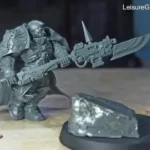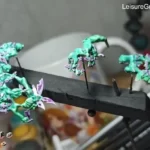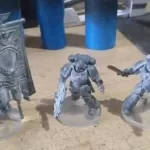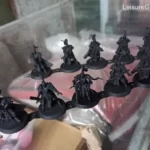Is an airbrush worth it for miniature painting? (Must Try)
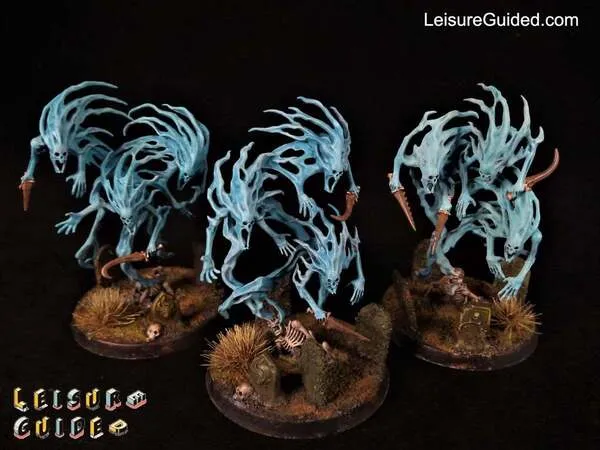
Most mini painters are primarily brush painters and have never directly worked with an airbrush. If you’re interested in airbrushing your minis, you need to know how well this technique will work on your miniature kits.
Is airbrushing convenient for base coating, highlighting, blending, and priming? Will it give better results and effects than a regular brush and spray can? You’ll be surprised at the results.
you Should start airbrushing your miniatures
If you’re wondering whether you should start airbrushing, the answer is yes.
When you airbrush your minis, you can preserve the littlest details, do amazing effects and have greater consistency in your coating applications than you can from a spray can or brush.
Airbrushes are incredibly useful for painting armies or lots of figures and it’s not just about basic paintings. It’s the possibility to prime, varnish, basecoat, pre-shade and even do technical effects like zenithal highlights that make airbrushing your miniatures a must-try.
Plus, you can also paint 80% of a figure to an above-table-top level, giving it a smooth and nice transition with little effort. It makes painting small figures and Dn’D minis incredibly quick.
What are the advantages and disadvantages of airbrushing?
Airbrushing your miniatures helps you get nice thin, even layer coats of any color you want. But, it also has its drawbacks.
Pros of using an airbrush on miniatures
- It is a fun way to paint minis since it allows you to play with functional trigger controls on the airbrush.
- It is a fast and reliable option for priming your miniatures.
- You’ll find it easy to do effects like zenithal shading and plasma coil glow.
- It lets you make smooth transitions between colors.
- it speeds up your painting and makes laying down a smooth base coat easy.
Cons of using an airbrush on miniatures
- Purchasing an airbrush is expensive
- Some airbrushes can be noisy. Thus, you’ll be unable to use it with other people around, especially during the wee hours of the night.
- Airbrushing your minis requires proper ventilation to ensure your space is free of toxic chemicals from the paint that may cause health and safety problems.
- Maintenance and cleaning are more time tasking than when using a hand brush.
- Temperature and humidity conditions impact the results you get from an airbrush so you can’t use it on some days and under low humidity.
airbrushing is easier than brush painting
Painting is easy, but I wouldn’t say it’s easier than airbrushing generally.
A paintbrush is easy to handle and will do almost anything an airbrush can as long as you use enough layers of paint. But, painting multiple figures with thin paint so that you get a decent and uniform blend requires much more skill than brush painting.
With a brush, you do multiple (10+) layers of very thin paint slowly transitioning from one color to the next.
With airbrushing, you can paint 10+ miniatures in minutes, no matter how thin the paint layers may be. Hence, it lessens your painting workload. However, you need to learn how to handle the airbrush, from trigger control to air pressure settings, thinning, masking, and spray distance to use it seamlessly for paint application.
Once you’ve figured this out, painting miniatures becomes easy.
Overall, painting with a brush and an airbrush is easy, but the airbrush takes the lead over paint brushing.
Is airbrushing miniatures hard to master?
As mentioned earlier, airbrushing has a learning curve. But, while it’ll require some practice to get consistent results, it is not hard to master.
The only problem you’ll likely face when using an airbrush for the first time is overspray. Plus, you might think that the process of cleaning the airbrush between each color-changing session is tedious, and knowing the right amount of thinner to mix with the paint may be time-tasking.
Once you get the hang of airbrushing, applying basecoats, blending colors, priming and shading will be easy.
Airbrushing gets good results
Airbrushing will help you achieve smooth results even for complicated colors like white and yellow. Plus, you get more precise results when blending and shading paint with a rattle can.
Zenithal shading with an airbrush is amazing
One of the best parts of using an airbrush is that you can easily create various effects that may be difficult or impossible to achieve with a synthetic or sable brush.
The most common effect is zenithal shading.
Zenithal shading gives you an effect that looks like highlights from observing something out in sunlight from up. You can also get glossy effects with an airbrush.
You can use your airbrush for any type of job
You can put any paint through an airbrush, and while a primer isn’t really paint, it has some paint pigments that make it similar to paints.
All you have to do is use a flow improver to get a milk consistency suitable for use in an airbrush.
If you’re considering priming with an airbrush, it only takes seconds to complete, and it dries fast.
Airbrushing miniatures will be faster
There’s nothing you can do with an airbrush that a spray can or regular brush can’t do, but you get faster results with the airbrush than with other painting techniques.
With an airbrush, you undercoat an entire 40K Warhammer army in an hour.
You can also get base coating and highlight done on over 30 figures much faster.
Is it safe to airbrush indoors?
Most experienced airbrush mini painters would prefer airbrushing their minis outdoors, especially if they use solvent-based acrylic paints or lacquer paints. But, that doesn’t mean you can’t airbrush indoors.
Technically, when using an airbrush, you are indirectly leaving tiny paint particles airborne thanks to the compressed air that blasts out the paint. These airborne particles may be toxic depending on the paint used.
Regardless of the paint’s toxicity, so long your workspace is well ventilated, airbrushing indoors is safe.
If your workspace lack windows for proper ventilation, a spray booth, respiratory mask, dust mask, or a fan will ensure proper ventilation.
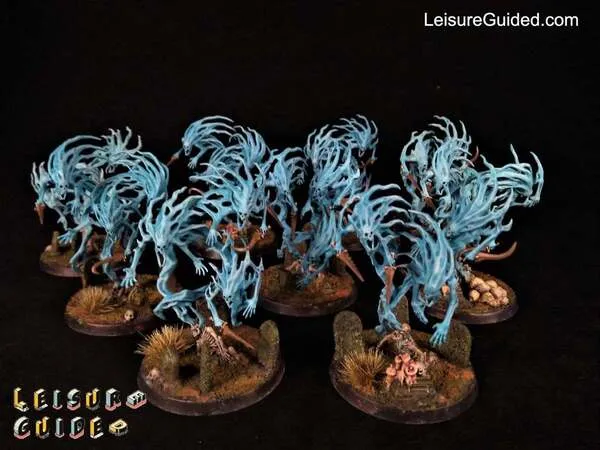

Is it more expensive to airbrush minis?
By now, you already know that getting an airbrush is pretty expensive. But, this disadvantage only lasts for a short time, and if you’re not invested in the hobby for long.
Once you get an airbrush with the compressor, it lasts as long as 10+ years, depending on how well you maintain it.
On the other hand, a rattle can or paint brush demands that you get them in bulk because you can easily exhaust them within a short time. Hence, in the long run, an airbrush is a good investment.
While an airbrush may cost 100 to 150 dollars and still last for 10 years, the total cost of getting regular brushes and rattle cans for 10 years may exceed this amount.
Your next step – what do you need to airbrush miniatures?
To start airbrushing your minis, you’ll need simple equipment like:
- An airbrush
- Compressor
- A hose to connect the airbrush to the compressor
- Airbrush cleaner
- Flow improver or water to thin the paint
- A spray booth if you spray indoors
- Paint
Conclusion
An airbrush is an excellent tool for base coating, shading, priming, and painting minis. It also allows you to do smooth color transitions and hard-to-do effects in minutes.
So, while it has a learning curve and can be a big investment in the short term, you’ll benefit from using it to paint your minis long term than with synthetic paint brushes and rattle cans.
Using an airbrush for miniature painting is definitely worth it.

